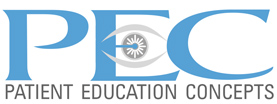It’s been almost three years since I was asked to be the “point person” for PEC’s custom website 
This experience has humbled me and allowed me to sympathize with current and prospective clients that call me and want to talk about web development. When they call I try VERY hard to keep the conversation “light” and questions “general”, but inevitably I have to ask things like “Do you have control of your domain?” ….there is usually a moment of silence after this question followed with either “I don’t know.” Or “What is a domain?” After that, the conversation, although necessary in order for me to correctly assess the situation and help them, starts heading in a very scary and complicated direction. I can literally feel the eyes of the person on the other end of the phone glazing-over and the tone of their voice changes. It’s clear they were unprepared for the complicated technical questions, are completely freaked-out and want the conversation to end quickly.
The next thing I hear is something like “Connie, I am so sorry. This stuff is all Greek to me.” And I always tell them to “Please STOP apologizing…Ophthalmology is Greek to me, so we’re even!”
With all this being said, I feel compelled to start off my first blog post by sharing some of my VERY BASIC, but helpful knowledge. Please know that my explanations are intended to be very un-technical. If you want the technical version…you’re not going to find it here. So, let’s get started with my pick for the Top 5 Scary Web Terms & Their Not-so-Scary Meanings:
#1) URL: URL stands for Uniform Resource Locator. A URL is a location identifier used by a web browser like Google, Chrome, FireFox, Yahoo, Bing and Safari to identify where a web page is located on a web server. Every server on the web is identified by an IP (Internet Protocol) address that is a series of numbers. It’s like the street address for the web. It tells the internet the location of the server. Because IP addresses are not “pretty”, we use Domain Names (next scary word on my list) to take the place of the IP address. For instance, if the world had not yet invented domain names, PEC’s URL would be something that looks like “134.56.8.064”. www.patientedconcepts.com is much prettier. There are lots of pages that make up a website, so a URL will display the location of the web pages located on the web server like: https://www.patientedconcepts.com/sight_selector.html . Typing this URL into your web browser will tell the web browser where to find this page on our website.
#2) Domain: As I touched on above, your “domain” is your web address. For instance, Patient Education Concepts’ domain is “patientedconcepts.com”. If you look-up the word domain on dictionary.com, the word domain is defined as; “Land to which there is superior title and absolute ownership.” The definition as it applies to an online reference is basically the same. Think of the internet as the earth. Think of your domain as land that YOU lease on the internet.
#3) Domain Registrar: Remember the earlier reference to your domain being the land that you lease on the web? A Registrar would be the place you leased the land from. They are also the place you go if you want to make changes to your lease (renew) or changes to the land (settings). They lease the land and help to keep the land safe by securing it so others cannot steal your land.
Things You (REALLY) Need To Know About Your Domain:
- How many domains you have and what they are.
- What company your domain is registered with (Network Solutions, GoDaddy, Enom, Register.com, etc.).
- The User Name & Password to access the account where your domain is registered.
- Who else besides you has access to the account and has authorization to make changes to your domain settings.
**Note – I’ve dealt with practices who own multiple domains that are located in multiple accounts. If you are one of these practices, it’s important to identify the above information for every domain you own.
I’ve come across SO MANY practices that have no information about any of this. When they want to change website providers, get an email from their ISP (Internet Service Provider) about email setting changes or want to purchase more domain names for an online marketing campaign, the time it takes to gather the necessary information becomes a very unnecessarily difficult task. Gather this information and make sure that someone at your practice (Office Administrator, Office Manager, Marketing Director) can access it when needed. If during the course of this research you find that you don’t have access or don’t actually own the domain you are using for your website, please take the time to rectify this. It’s in your best interest to do so.
#4) HTML: HTML stands for Hyper Text Markup Language. A software program is built using a language, called code, that tells the software program how it looks, and what it needs to do when a particular action is taken by the user. A website is similar to a software program in that it is built using a special kind of code that tells the website to respond a certain way when the website visitor clicks on something. One type of code used to build websites is HTML. HTML looks very scary to the untrained eye. If you want to see what it looks like you can open your Internet browser, visit your favorite website, right-click anywhere on the homepage and select “View Page Source”. After taking a quick peek I am confident that you will NEVER want to see it again…it’s not pretty. It is very difficult wrap your brain around the idea that, what looks like one hot mess of characters on the page, makes up the beautiful masterpiece you see in your internet browser.Depending on the design of the website a single webpage can be comprised of more than a hundred lines of code. I’ve recently started to learn how to make very basic webpage edits HTML web pages and, let me tell you, I have a very deep respect for someone who spends their entire work day building web pages. The time and attention to detail that is required to build an entire website is something I cannot even fathom.
#5) CMS: CMS stands for Content Management System. There are content managers for lots of things, but as it relates to websites a CMS allows for accessing and editing website content without needing to know how to use HTML. The Content Manager provides a user interface that is very similar to a word processing program, like Microsoft Word, that lets you format or edit the various elements of a web page like add or removing text, changing the format of text (bolding, bullets, colors, etc.) adding photo’s and video. The CMS also provides a comprehensive organizational structure to the web pages that make up the site. In most cases the CMS allows you to also modify the organizational structure of the web pages.
See, that wasn’t so bad, was it? Any web terms evoke fear or confusion in you or your clients?
